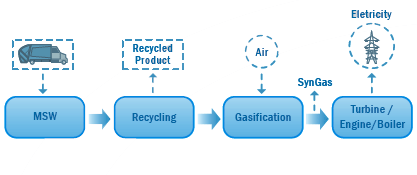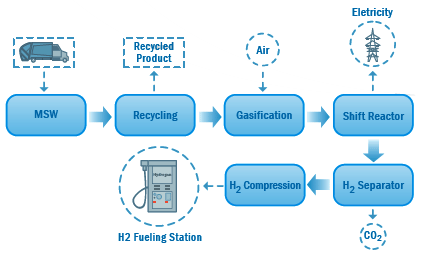| Transfer Stations |
| Conversion of MSW Transfer Stations into
Renewable Energy Centers |
Municipal Solid Waste Transfer Stations (MSWTS) play an important
role in a community’s total waste management system, serving as
the link between a community’s solid waste collection program and
a final waste disposal facility. W2E has developed an innovative
system of converting municipal solid waste (MSW) into a slate of
usable energy and energy-related products.
MSWTS currently provide the standard intermediate handling step in
MSW disposal, preliminary to the disposal of non-recyclable wastes
at a landfill or incinerator. MSWTS facilities can make MSW available
in large quantities, on a continuous basis. W2E has targeted these
sites to become Alternative Energy Centers, which will eliminate
MSW disposal issues and make energy from one of the most
available domestic sources of renewable power worldwide |
| |
In a landfill the biodegradable components of MSW (e.g., paper
and food wastes) decompose and emit methane – a greenhouse
gas 23 times more potent than carbon dioxide. Other components
(e.g., leachate) can also cause significant pollution in air and ground
water.
Incineration, another disposal option for this waste, is already
restricted in the USA. A known source of air emissions pollutants,
such as dioxins and furans, incineration is under close scrutiny and
can face resistance in other parts of the world. These options waste
a valuable resource by not making use of it. |
| |
| ALTERNATIVE ENERGY CENTERS |
| |
| The conversion of these transfer stations into Alternative Energy
Centers (AECs), to use the MSW onsite to produce a variety of
energy and energy-related products is a practical alternative to the
standard disposal options for this material. These AECs could achieve
a significant reduction in dependence on imported fossil fuels by
making use of these domestic resources. They will also increase
energy security by creating geographically dispersed distributed
energy centers, and at the same time, provide a more realistic waste
disposal option for a growing world population that is demanding
and using more goods and services and as a result, producing
more waste. |
| |
| At an MSWTS, the material is received and the recyclables separated
out, collected and sold to the appropriate recycler (scrap metal,
plastics, etc). After the recyclables are removed, some MSWTS will
take the remaining MSW and shred it to make a “fluff”. The fluff has
a heating value of 7000 BTU/lb to 9000 BTU/lb. The moisture content
of the fluff is 30-35%, which is in the ideal range for processing it into
alternative energy products using a W2E process. |
| |
| Potential of Energy Products generated from 100 Tons/day of MSW
delivered at the Transfer Station |
| |
| |
| Energy Form |
MSW Processed |
ENERGY PRODUCT GENERATED |
| Steam |
100 Tons/Day |
23 Tons/Hr |
| Electricity |
100 Tons/Day |
5 MW (Gross) |
| Hydrogen |
100 Tons/Day |
6000 kg/day |
| Ammonia |
100 Tons/Day |
35 Tons/day |
| |
|
|
| PRODUCTION OF ELECTRICITY |
| |
| For the production of electricity, the solid MSW fluff is reacted with
air under substoichiometric conditions to produce clean fuel gas – a
process known as gasification. This clean fuel – often called syngas
- is then utilized either in a gas engine, a gas turbine, or in a steam
boiler to produce electricity and/or steam. |
| |
 |
| PRODUCTION OF HYDROGEN |
| |
| For the production of hydrogen, the solid MSW fluff is reacted with
air under substoichiometric conditions to produce clean fuel gas– the gasification process. The clean fuel gas, or syngas, contains
CO, H2, CO2, H2O, and N2. After adding more water to it, this gas is
further reacted in a “shift reactor”. In a shift reactor, CO is shifted
to H2 and CO2. The hydrogen component is then separated from the
gas mixture by using a pressure swing absorption (PSA) unit to yield
pure hydrogen. This pure hydrogen can then be compressed for use
in a hydrogen fueling station. |
| |
 |
| |
| |
|
| |
|
|
|

